The Stringed Instrument Database
G
Gabusi
- See Kibangala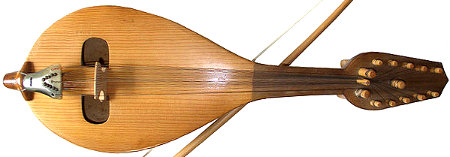
Gadulka
Alternative names:
Origin: The Balkan region
Tuning: Usually A3, E3, A4 but sometimes A, A, E (Dobrudja tuning) or A, E, D (Lingourie tuning).
Strings/Courses: 3/3
Further notes: 3 playing strings, with up to 10 sympathetic strings. Strings made of nylon or horse hair.
Scale Length: 330-350mm

Gambus
Alternative names: Panting
Origin: Malaysia.
Tuning:
Strings/Courses: 10/5, 12/6 or 8/4.
Further notes: Nylon strings.
Scale Length: About 600mm, but a wide variation.
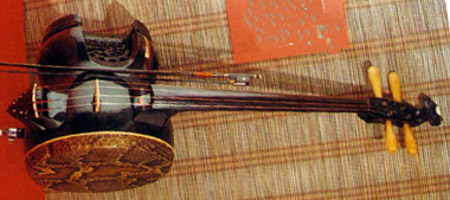
Gehu
Alternative names: Erhu-cello,
Origin: Invented by Yang Yusen in China during the 20th century.
Tuning: C2, G2, D3, A3 (Same as a cello)
Strings/Courses: 4/4
Further notes: Like a giant erhu body turned on it's side with a cello neck and head.
Scale Length:

Gekkin
Alternative names:
Origin: Japan.
Tuning: A3, D4, D4, D5.
Strings/Courses: 4/4 or 3/3
Further notes: Evolved from the Chinese Yueqin.
Scale Length:
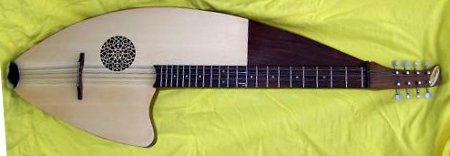
Geyerleier
Alternative names:
Origin: Hamburg, Nothern Germany. A relatively recent invention.
Tuning: E3 E2, B3 B2, E3 E3, B3 B3 or D3 D2, A3 A2, D3 D3, A3 A3.
Strings/Courses: 8/4
Further notes: Steel strings.
Scale Length: Around 600mm.

Ghijak
Alternative names: Ghidjak, Gijak,
Origin: Uzbekistan.
Tuning:
Strings/Courses: 4/4 or 3/3
Further notes: Evolved from the Iranian Kemenche. Can have 3 or 4 strings.
Scale Length:
Gimbri / Guimbri
- See Lotar.Gopichand / Gobichand
- See Ektara.
Guariquena
- See Bandola Central.

Gue
Alternative names:
Origin: Shetland, north of Scotland, UK.
Tuning:
Strings/Courses: 2/2
Further notes: Probably evolved from similar Scandinavian instruments brought there by the Vikings. Was popular until the 1800's, when it became quite rare. It was revived in 2007.
Scale Length: No standard.

Guitar
Alternative names:
Origin: Spain, 15th century
Tuning: E2, A2, D3, G3, B3, E4
Strings/Courses: 6/6
Further notes: Classical guitar always has nylon strings. There are also many folk guitars with steel strings.
Scale Length: 650mm
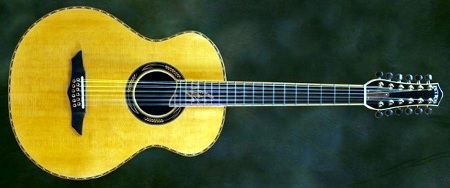
Guitar, 12-string
Alternative names:
Origin: 1920's. Seems to have been invented in more than one country. The prominent inventors were in Brazil and the USA.
Tuning: Nowadays E3 E2, A3 A2, D4 D3, G4 G3, B3 B3, E4 E4, but traditionally C3 C2, F3 F2, A#4 A#3, D#4 D#3, G3 G3, C4 C4 or B2 B1, E3 E2, A4 A3, D4 D3, F#3 F#3, B4 B4 to reduce the high tension.
Strings/Courses: 12/6
Further notes: Always steel strings.
Scale Length: 650mm
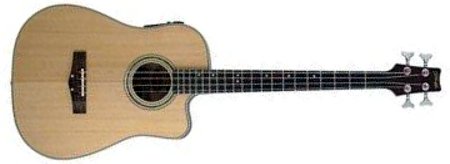
Guitar, Bass
Alternative names:
Origin: Electric basses first appeared in the USA in the 1930s. The first acoustic bass was invented in the USA in 1972.
Tuning: E1, A1, D2, G2
Strings/Courses: 4/4
Further notes: Bass Guitars are usually electric. The picture above is of an acoustic Bass Guitar, because this website deals with acoustic instruments. Steel strings.
Scale Length: 760-870mm
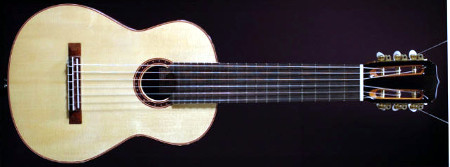
Guitar, Octave
Alternative names: Soprano guitar, Piccolo guitar.
Origin:
Tuning: E3, A3, D4, G4, B4, E5
Strings/Courses: 6/6
Further notes: Nylon strings.
Scale Length: 400-430mm

Guitar, Requinto
Alternative names:
Origin: Spain, 15th century
Tuning: A2, D3, G3, C3, E4, A4 or A2, D3, G3, B3, E4, A4
Strings/Courses: 6/6
Further notes: Now especially popular in Mexico. Nylon strings.
Scale Length: 530-560mm
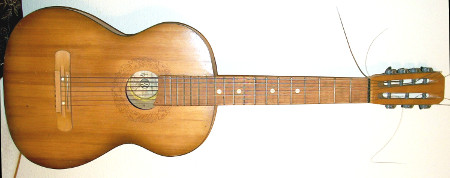
Guitar, Russian
Alternative names: Semistrunnaya gitara, Semistrunka, Russian gypsy guitar.
Origin: Russia, 18th century
Tuning: D2, G2, B2, D3, G3, B3, D4
Strings/Courses: 7/7
Further notes: A traditional 7-string guitar in Russia that evolved from the Cittern. Always has steel strings.
Scale Length: 610mm
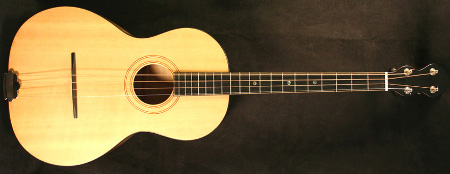
Guitar, Tenor
Alternative names:
Origin: USA, 1910s or 20s.
Tuning: C3, G3, D4, A4 is the standard tuning, but sometimes it is tuned (with heavier strings) to G2, D3, A3, E4.
Strings/Courses: 4/4
Further notes: The Tenor Guitar was invented to allow Banjo players to acheive a Guitar sound without re-learning tunings and chord patterns. Steel strings.
Scale Length: 530-590mm
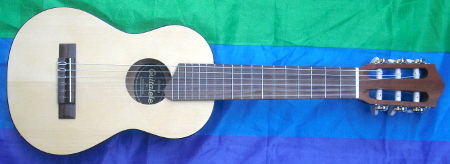
Guitarlele
Alternative names: Guitalele, Guilele, Kiku
Origin: Invented by Yamaha, Japan, 1997.
Tuning: A3, D4, G4, C5, E5, A5
Strings/Courses: 6/6
Further notes: Hybrid between a classical Guitar and a tenor Ukulele. Nylon strings
Scale Length: 435mm

Guitarra Chamula
Alternative names:
Origin: Chiapas, Southern Mexico.
Tuning:
Strings/Courses: 10/5 or 12/6
Further notes: Steel strings.
Scale Length:
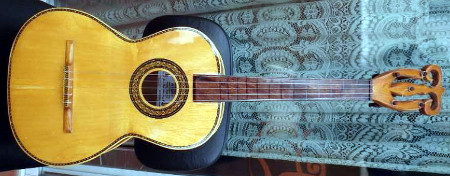
Guitarra De Golpe
Alternative names: Guitarra Colorada, Quinta De Golpe, Mariachera
Origin: Jalisco and Michoacan, western Mexico
Tuning: D3, G3, C4, E3, A3 (Standard tuning) or D3, G3, B4, E3, A3 (Tecalitan tuning) or G3, C4, E4, A3, D4 (Urbana tuning, sometimes with the middle E an octave lower)
Strings/Courses: 5/5
Further notes: Nylon strings.
Scale Length: 600mm.
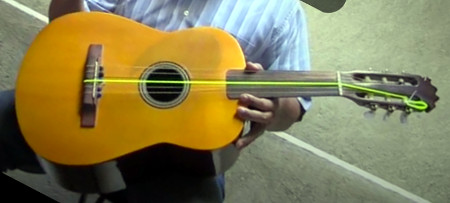
Guitarra Panzona
Alternative names: Guitarra Tua, Guitarra Blanca
Origin: South-eastern Mexico
Tuning: A2, D3, G3 G2, B2, E3
Strings/Courses: 6/5
Further notes: Nylon strings. Similar to the Mexican Guitarron, but with a flat black instead of the rounded one, and a shorter scale length. It also has 5 courses (with a doubled middle course), instead of the 6 single strings of the Guitarron.
Scale Length:
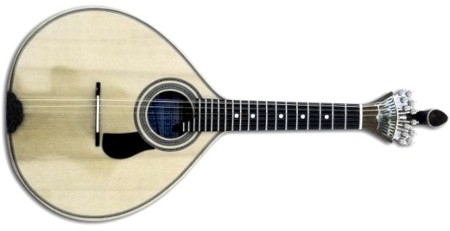
Guitarra Portugesa
Alternative names: Portugese Guitar
Origin: Portugal, early 19th century.
Tuning: D3 D2, A3 A2, B3 B2, E3 E3, A3 A3, B3 B3 for the Lisbon variant. C3 C2, G3 G2, A3 A2, D3 D3, G3 G3, A3 A3 for the Coimbra variant.
Strings/Courses: 12/6
Further notes: Portugese for 'Portugese Guitar', although this name is misleading, because it is actually a descendent of the cittern, being related to the 'English guitar'. There are two varieties, Lisboa/Lisbon and Coimbra, named after the areas they come from. Steel strings.
Scale Length: 445mm for the Lisbon variant, 470mm for the Coimbra variant.

Guitarra Septima
Alternative names: Guitarra Setima
Origin: Eastern Mexico, 18th century
Tuning: BB, EE, AA, DD, G, B, E or BB, EE, AA, DD, GG, BB, E.
Strings/Courses: 13/7 or 11/7
Further notes: Quite rare nowadays. Gut or nylon strings.
Scale Length:
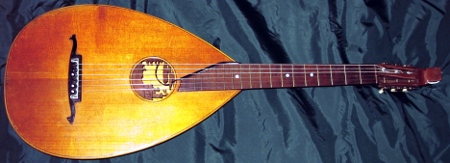
Guitarrenlaute
Alternative names: Guitarren laute, Guitar-lute, Lute-guitar.
Origin: Germany, early 20th century.
Tuning: E2, A2, D3, G3, B3, E4
Strings/Courses: 6/6
Further notes: Usually has steel strings, though sometimes nylon.
Scale Length: 650mm

Guitarro
Alternative names: Guitarrico
Origin: Aragon, Spain. Probably originated around the same time as the baroque Guitar.
Tuning: B4, F#4, D5, A5, E5 or B4, F#4 F#4, D5 D5, A5 A5, E5.
Strings/Courses: 5/5 or 8/5
Further notes: Nylon strings.
Scale Length: 420-450mm
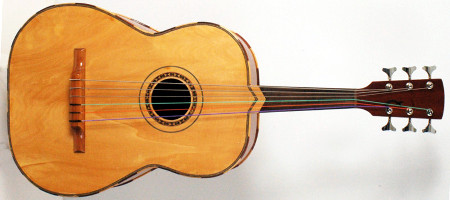
Guitarron
Alternative names: Guitarron de Toloche, Guitarron Mexicano (to differentiate from the Guitarron Chileno).
Origin: Mexico
Tuning: A1 D2 G2 C3 E3 A2
Strings/Courses: 6/6
Further notes: Spanish for 'large Guitar'. Nylon strings.
Scale Length: 650-750mm
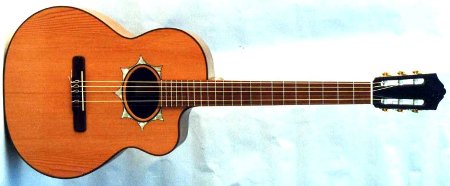
Guitarron Argentino
Alternative names:
Origin: Argentina
Tuning: B1, E2, A2, D3, G3, B3 or B1, E2, A2, D3, F#3, B3
Strings/Courses: 6/6
Further notes: Spanish for 'Argentinian large Guitar'. Nylon strings.
Scale Length:
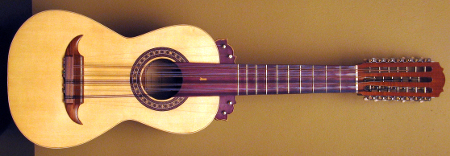
Guitarron Chileno
Alternative names:
Origin: Chile
Tuning: F#5, A4, D4 D4 D3 D3 D2, G4 G4 G4 G3 G3, C4 C4 C3 C2, E4 E4 E4, A4 A4 A4, G4, B4
Strings/Courses: 24/9 or 25/9
Further notes: Spanish for 'Chilean large Guitar'.Steel strings.
Scale Length: 580mm
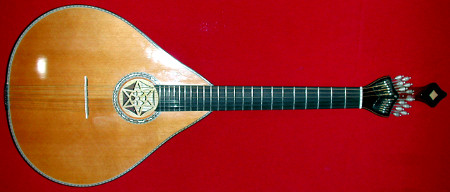
Guitolao
Alternative names:
Origin: Portugal, early 19th century.
Tuning: G2 G1, D3 D2, E3 E2, A2 A2, D3 D3, E3 E3.
Strings/Courses: 12/6
Further notes: Tuned a fifth below the Lisbon tuning for the standard Guitarra Portugesa. Steel strings.
Scale Length: 620mm

Guqin
Alternative names: Ku-ch'in, Guchin, Kuchin, Goocheen.
Origin: China, 3000 years ago!
Tuning: C2, D2, F2, G2, A2, C3, D3
Strings/Courses: 7/7
Further notes: Chinese for 'ancient string instrument'. Nylon or silk strings.
Scale Length: 1000-1200mm
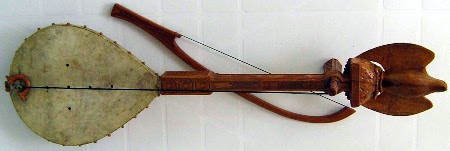
Gusle
Alternative names: Gusli, Guzla
Origin: Balkan region, south-east Europe.
Tuning:
Strings/Courses: 1/1
Further notes:
Scale Length: